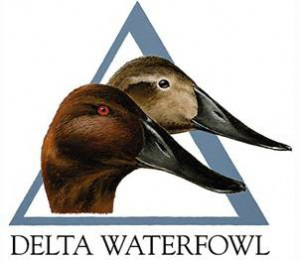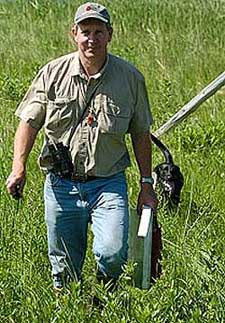Delta Waterfowl Scientific Director Dr. Frank Rohwer, a 20-year duck hunting veteran in the coastal marshes of Louisiana, discusses how the spill could impact the region’s coastal marshes, wintering ducks, and passionate waterfowling culture.
“It’s a special, special place, and it breaks my heart seeing it despoiled more and more with each passing day,” he said.
Like other Gulf Coast waterfowlers, Rohwer is worried about the ongoing oil spill and what its impact will ultimately be on coastal wetland habitat and its fish and wildlife.
“This is environmental disaster that could affect ducks and duck hunters for years to come,” said Rohwer, who is also a professor at Louisiana State University’s School of Renewable Natural Resources.
When will ducks start to show up in coastal marshes around Louisiana and elsewhere?
We’ll start to see adult blue-winged teal sometime in mid to late August and have large numbers pass through in September. A surprising number of pintails show up really early in the fall as well. Some wood ducks are early migrants, but they stay in forested habitat away from the coastal marshes. We get another big wave of ducks starting in October-mostly a mix of gadwall, green-winged teal, more pintails, and some wigeon. The biggest crush of birds-divers like canvasbacks, scaup and redheads and more puddle ducks-move in in late November and early December.
What about mallards?
Few mallards use the coastal marshes.
We’ve seen the photos of brown pelicans coated in oil. Is this likely to happen to wintering ducks and, if so, what’s the likely impact?
The greatest numbers of ducks that use the Gulf Coast are dabbling ducks. Right now, few dabblers are likely to come into contact with the “orange moose”-the super-sticky oil you see on brown pelicans. The reason: dabbling ducks hardly use the saltwater bays where most of the inshore oil is located. Dabbling ducks overwhelmingly use inland freshwater marshes, which are some distance from the edge of the Gulf. Large numbers of dabblers may be affected by oil, but that would be a worse-case scenario.
Diving ducks are another story. Divers make much use of the coastal bays where there has been a lot of oil in recent weeks. Last winter, for example, I saw rafts of thousands of divers-canvasbacks, redheads and scaup-in bays behind the Isles Dernieres, one set of barrier islands near Cocodrie, Louisiana. Barrier islands are the first line of defense against storm-driven waters like hurricanes Katrina and Rita. Until recently, few of us realized how valuable barrier islands could be for protection against an unnatural disaster like a massive oil spill. Cleaning oil off a beach is a far simpler than cleaning oil from marshland.
Oil could directly impact diving ducks. Will a lot of divers get oiled?
That’s hard to predict. There are some reasons to be hopeful. First, we have more than four months before divers get that far south, and the cleanup effort is massive and much of the oil may be removed before they get there. Second, some seabirds that extensively use these coastal bays in summer appear to have been fairly adept at avoiding the oil. Brown Pelicans breed in small islands in the coastal waters and some of these islands have had large amounts of oil right up to their banks.
Nesting pelicans are closely tied to the colony island, so they have a hard time avoiding the oil. We can only hope that wintering ducks will be better able to move around and avoid the oil. We are fortunate that we have no experience with this type of disaster. Of course, that also means that ducks have no experience with oil, so they may have little predisposition to avoid it.
Can ducks survive if they get oiled?
It’s questionable. They face two major threats. First, the oil disrupts their feather coat and makes ducks vulnerable to cold water that normally presents little risk. Second, in the process of trying to clean and waterproof their feathers, many birds actually ingest toxins that are in the hydrocarbon soup called crude oil. For ducks, the first issue may be more problematic. The midsummer conditions in Louisiana are anything but cold. But ducks will face cold coastal waters in late fall and winter, and that’s a threat to them. Oil disrupts the boundary layer of aquatic birds’ feathers, so their normally water-tight feathering allows water to make skin contact. Warm water isn’t the problem; cold is. Ducks whose skin is exposed to cold water can actually freeze to death in short order.
We know ducks and other birds ingest oil. How do they do it and what are the consequences?
Ducks and other birds ingest oil by preening their feathers to remove oil and reapply their glandular waterproofing. In some spills the crude is so toxic that exposed birds that preen themselves quickly ingest lethal doses and die from the toxins long before they face cold stress. One of the apparent advantages of such a deepwater spill is that there is much time for the oil’s most volatile and perhaps most toxic compounds to disappear before the oil gets near the shore and can make contact with waterfowl and seabirds. It appears that the crude’s most toxic elements have volatilized and entered the atmosphere or have mixed with seawater by the time the oil gets inshore.
Coastal marsh habitat has been on the decline for years. Why is that?
Louisiana’s coastal wetlands, especially those on the Deltaic Plane-the area east and west of the Mississippi River-have been declining for decades because they are being flooded out of existence. These marshes have been starved of new sediments for years because we’ve engineered the Mississippi River to stay within its banks until it is nearly 100 river miles south of New Orleans.
That means all the new sediments that are coming from this huge river basin are being carried by the swiftly flowing water until they drop off the continental shelf. In the old days during spring floods, these sediment loads were spread over much of south Louisiana and, as a result, replenished the marshes. Not anymore. The upshot is that we’ve engineered dikes that force the river to use a deep, narrow channel. This keeps people and their property safe during floods and enables huge ships to move up and down the river. However, this comes with an unexpected consequence: we lose the sediments that have historically sustained our coastal marshes.
How does oil negatively impact Louisiana’s barrier islands and coastal marshes? Will it further exacerbate the erosion that has been a problem for coastal marshes for some time?
These two habitats probably face very different fates. The barrier islands will probably face fairly minor long-term impacts from the oil, but a substantial fraction of the marshland could be irrevocably destroyed. Barrier islands are mostly lumps of sand with vegetation on the dunes. They typically have shell and sand beaches on the ocean side and some marsh development on the landward side. The oil that fowls the landward side is very likely to kill the vegetation that provides fish and wildlife habitat. However, loss of this vegetation does not seriously jeopardize the integrity of the islands.
The marshes in much of Louisiana are extremely fragile and it is the plants that provide the structure that keeps the marsh from completely degrading. So if the oil kills the marsh grasses, especially the predominant salt marsh cordgrass, then this oil spill could lead to the permanent demise of hundreds of thousands of acres of salt marsh.
If we lose additional acreages of these marshes, what are the short- and long-term consequences to wintering waterfowl?
In the short term the marshland most affected and first to be lost will be the marsh at the edge of the coastal bays-marshland that has salt or brackish water. Those are not the most productive marshes for waterfowl, so the short-term loss of habitat may be minor. However, if saltwater begins to intrude in our more inland freshwater marshes, there will be less good freshwater habitat for wintering waterfowl and other wetland species.
The long-term impacts are difficult to evaluate, but it may not be as bad for wintering ducks as might be expected. Waterfowl biologists often suggest that five million ducks winter in Gulf Coast marshes. However, there are a variety of estimates suggesting that the region has enough food resources to support many more ducks in its current state. Still, if extensive losses occur, the reduction of marsh quantity and quality may impact the food resources to the extent that ducks wintering in the area are at risk.
If Louisiana’s freshwater coastal marshes get overrun with oil, will ducks adapt and winter elsewhere?
Yes, this is quite likely. Ducks in the winter are pretty adaptable and will move around to find food and to avoid disturbance. However, I do worry ducks will use their traditional habitats and get oiled before they figure out there’s a scarcity of food. After all, ducks looking for food tend to move around a lot, which surely increases their odds of finding an oil patch.
What are the best- and worse-case scenarios?
The worst case scenario is hard to imagine. For one, we have little understanding of how this will impact the coastal ecosystem as a whole and over the long term. But in the near term it is easy to envision this disaster being really bad for ducks and duck hunting in Louisiana. Right now the oil is in coastal waters and it could stay there. In the best-case scenario the oil flow gets shut off soon, the escaped oil mostly says out of the marshes and the coastal bays, and the clean-up crews recover most of the inshore oil before November. That is probably an unrealistic hope; a more modest hope is the oil remains restricted to coastal bays. That may mean that only diving ducks could face a high risk of being oiled.
The worst-case scenario is that the oil continues to spew until late summer and then a major tropical storm brings a huge storm surge-a 10- to 20-foot wall of water pushed ahead of major hurricanes. Ike and Rita brought huge amounts of high saltwater dozens of miles inland, which caused a major burn to the freshwater marsh. Recovery from such a salt burn can take years, because the salt has to be flushed out by rain. Imagine a storm tide carrying oil over the protective salt marsh and dumping it on the productive fresh marsh. That would be a disaster for ducks-both in the short term with oil exposure and loss of food. Worse yet, it could take years, perhaps decades for the freshwater marsh to recover from the oil. Ducks wouldn’t be the only casualties, either. A worst-case scenario would be a major blow to Louisiana’s coastal waterfowl hunters. After all, we take our duck hunting very seriously.

















